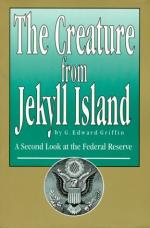
|
| Name: _________________________ | Period: ___________________ |
This test consists of 5 multiple choice questions, 5 short answer questions, and 10 short essay questions.
Multiple Choice Questions
1. When was the first central bank founded in the US?
(a) The first central bank was founded in the US before the Spanish-American War.
(b) The first central bank was founded in the US before the Constitution was drafted.
(c) The first central bank was founded in the US after the Constitution was drafted.
(d) The first central bank was founded in the US before the Civil War.
2. What was the goal of the secret society founded by Lord Alfred Milner?
(a) A secret society, founded by Lord Alfred Milner, had as its goal the democratization of the entire world.
(b) A secret society, founded by Lord Alfred Milner, had as its goal the dominance of the world through money controls.
(c) A secret society, founded by Lord Alfred Milner, had global peace as its main goal.
(d) A secret society, founded by Lord Alfred Milner, had as its goal the eradication of disease and hunger.
3. What restrictions were placed on the Bank of Amsterdam which was established in 1609?
(a) In 1609 the Bank of Amsterdam was formed and restricted from taking foreign deposits.
(b) In 1609 the Bank of Amsterdam was formed and restricted from making more loans than the deposits it received.
(c) In 1609 the Bank of Amsterdam was formed and restricted from making loans with its deposits.
(d) In 1609 the Bank of Amsterdam was formed and restricted from using over twenty percent of its revenues for loans.
4. What portion of the U.S. debt did a large portion of the tax dollar pay for?
(a) The U.S. debt continued to grow with a large portion of tax dollar going into paying the principal on the debt.
(b) The U.S. debt continued to grow with a large portion of tax dollar going into paying only the interest on the debt.
(c) The U.S. debt continued to grow with a large portion of tax dollar going to US war efforts.
(d) The U.S. debt continued to grow with a large portion of tax dollar going to entitlement programs.
5. What was really behind the Russian Bolshevik Revolution?
(a) The Russian Bolshevik Revolution was a revolution of and for the people.
(b) The Russian Bolshevik Revolution was not a revolution of and for the people, as history usually asserts, but the manipulations of foreign interests.
(c) The Russian Bolshevik Revolution was not a revolution of and for the people, as history usually asserts, but the manipulations the Axis Powers.
(d) The Russian Bolshevik Revolution was not a revolution of and for the people, as history usually asserts, but the manipulations of a handful of financiers.
Short Answer Questions
1. What dispute did President Andrew Jackson have with the leader of The Second Bank?
2. After the 1950s, what was the standard of measure used to estimate the US debt?
3. How did Nicholas Biddle, leader of The Second Bank, respond to President Andrew Jackson's opposition to him?
4. The Rothschilds financed the conflict in which what historic leader was defeated by England?
5. What caused England to nearly go broke?
Short Essay Questions
1. In Chapter 16, when was the first central bank founded in the US?
2. According to Chapter 24, what decade marked the beginning of a tremendous surge in U.S. debt?
3. In Chapter 11, what place in history does the Rothschild family hold?
4. According to Chapter 12, what event sparked the conflicts that led to World War I?
5. According to Chapter 13, what was really behind the Russian Bolshevik Revolution?
6. According to Chapter 15, why was the use of fiat money disallowed in the United States?
7. According to Chapter 9, what culture first developed the the modern equivalent of the banking industry?
8. According to Chapter 21, what system was in control of the economy before the Federal Reserve System was established?
9. What realistic scenario was discussed in Chapter 26 involving the U.S. monetary system?
10. In Chapter 10, what resulted from the Mandrake Mechanism?
|
This section contains 1,079 words (approx. 4 pages at 300 words per page) |

|




